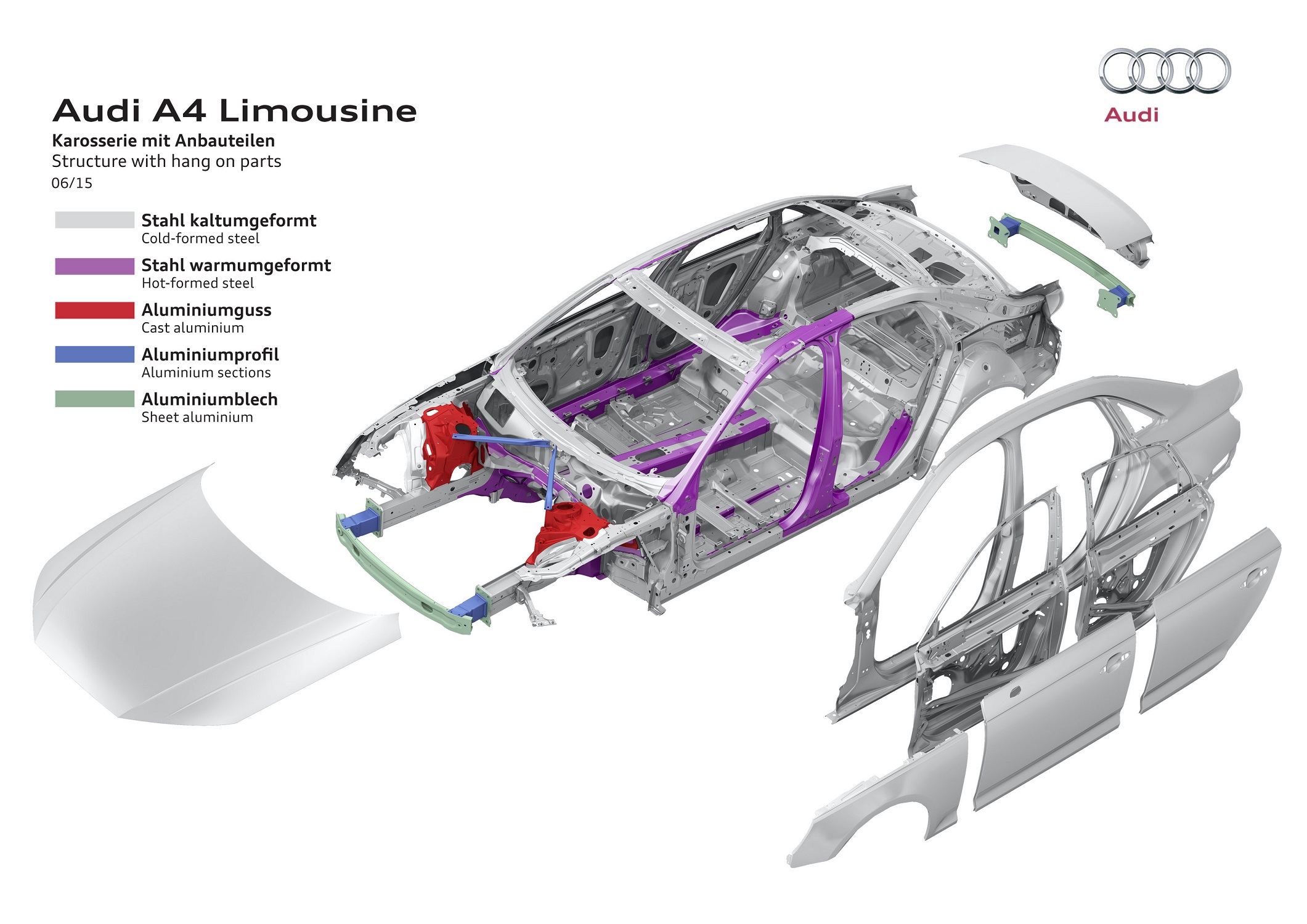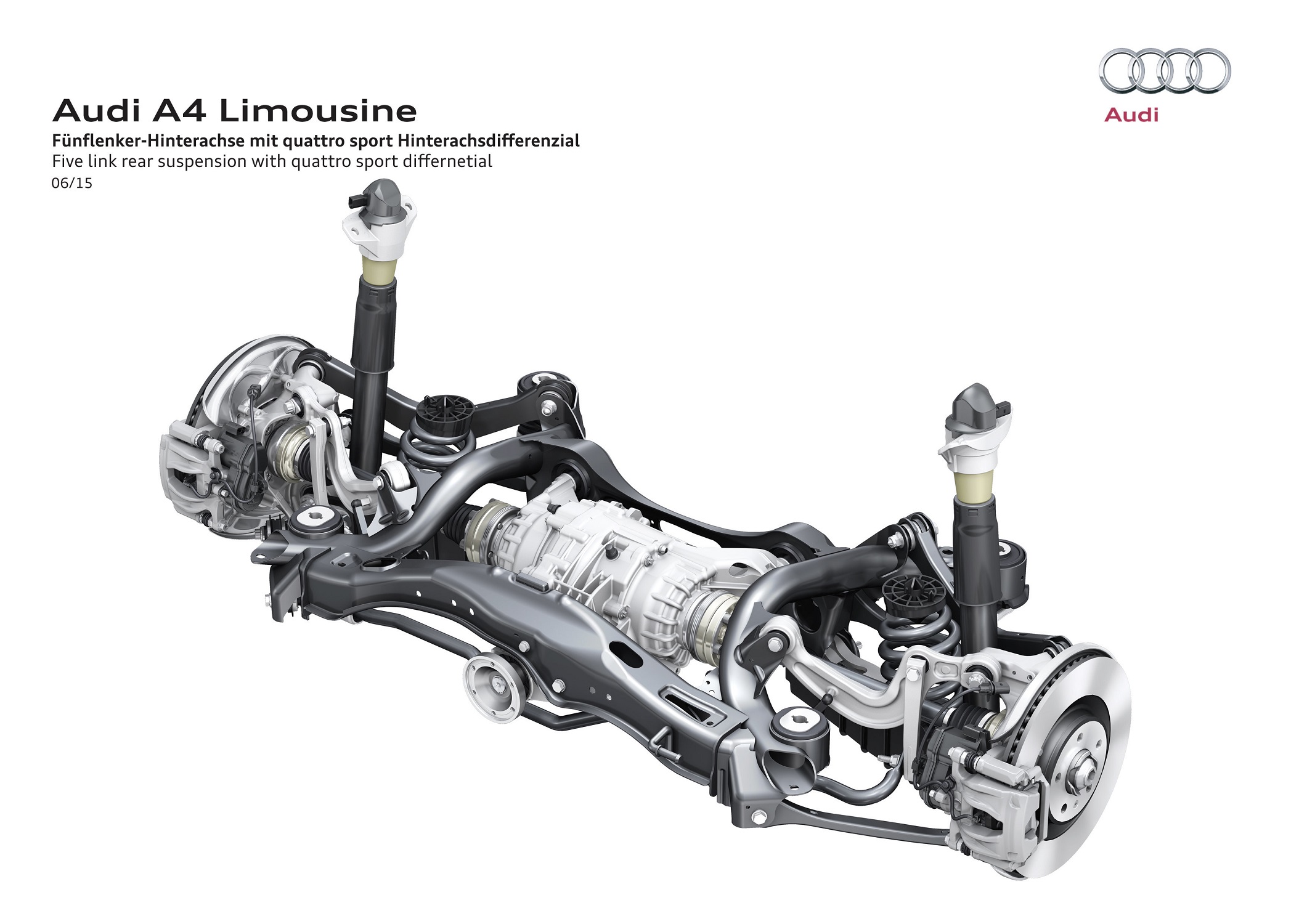The new-generation Audi A4 and A4 Avant have been redeveloped so that it aims at defining the benchmark in the segment. During the development work, high priority was placed on the reduction of CO2 emissions and lightweight design.
Lightweight body
Despite the increased dimensions, the Audi A4 and A4 Avant weigh up to 120 kilograms (264.6 lb.) less than the previous models – the base Sedan 1.4 TFSI, which will follow soon after the initial market launch, weighs 1,320 kilograms (2,910.1 lb.) empty and without driver. With this lightweight construction, the body is one of the lightest in its class. It is 15 kilograms (33.1 lb.) lighter than its predecessor, thanks to geometrical lightweight construction and an intelligent combination of materials.
The module cross member under the dashboard is made of extruded and sheet aluminum, while the front cross member is an extruded profile. On the new A4 Avant, the nodes in the upper ends of the D-pillars are made of die-cast aluminum and the tailgate is also aluminum. The deep drawing of the tailgate in the press takes place with a device known as an intelligent tool: Laser sensors measure how the sheet metal behaves during the process; if necessary, electrically operated drawing aids make small adjustments to the press. This results in higher precision in the magnitude of thousandths of millimeters.
The mounts for the front MacPherson struts are highly integrated aluminum castings. Compared with components made of sheet steel, which are welded together out of several parts, they reduce weight by a total of eight kilograms. This construction allows a stiff connection between the upper ends of the struts and the car body, thus ensuring optimal conditions for driving dynamics.
In the new Audi A4 and A4 Avant, the hot-stamped components form the high-strength, crash-proof backbone of the passenger compartment. They strengthen the transition from the front of the car to the interior, the frontal area of the roof frame, the B-pillars, the door sills and parts of the floor. They constitute 17 percent of the body structure.
Other lightweight design choices
In these new Audi mid-sized models, the electric systems also contribute to the light vehicle weight: enhanced topology, new aluminum cables and an AGM battery lower the weight by six kilograms (13.2 lb.) in comparison with the earlier model.
Components made of magnesium and a light wire frame are used in the rear seats; the substructure of the front seats is made of high-strength steel. Compared with the previous model, the weight of the seats has been reduced by up to nine kilograms. A new carpet, an aluminum brake pedal and foamed defrost ducts in the air-conditioning system shave another four kilograms (8.8 lb.) off the weight.
The manual transmission, which is standard equipment for all TFSI engines and for the four-cylinder TDI engine, is an all-new development. Much of its housing is made of magnesium. A spur-gear stage replaces the shaft to the front-axle differential used on the previous model, providing great advantages in terms of friction and space requirements. Open gearwheels, hollow shafts and a smaller clutch reduce the transmission’s weight further with the end result that the new unit is 16 kilograms (35.3 lb.) lighter than the old one.
Audi also decided on all-new electromechanical power steering, saving 3.5 kilograms (7.7 lb.) compared with the previous model.
In the rear of the new Audi A4 and A4 Avant, a five-link axle replaces the trapezoidal-link axles of the previous model. By means of an intelligent combination of materials, the weight of the axle components has been reduced by another five kilograms.
The lightweight concept is completed with the use of monotube dampers and high-strength, thin-wall tubular stabilizer bars and segmented wheel hubs. Compared with the previous model, the weight of the front axle has been reduced by six kilograms.
Source: Audi
Romain’s opinion:
It seems that from a vehicle generation to another the weight is decreasing a lot with the usage of aluminum and innovative materials. Do you think that carbon fiber will be extensively used in future’s passenger cars? What will be the weight of a car in 2030?




















